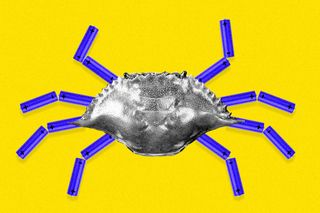
Scientists Used Crab Shells to Make Safe, Sustainable Batteries
The batteries could be an alternative to lithium ion batteries, which take hundreds of thousands of years to degrade.

Almost everything today is powered by batteries: phones, fleets of vehicles, clean energy projects. These have a long lifespan and immense storage capacity. But there’s a fatal flaw in their persistent use: currently made of lithium, batteries take hundreds of thousands of years to degrade, and the way they are disposed of currently poses an environmental risk.
Researchers recently chanced upon an alternate source — one that uses a material found in crab shells — to store energy. In a study published this month in the journal Matter, a group of scientists from the University of Maryland and the University of Houston demonstrated a way to make eco-friendly zinc-based batteries using the exoskeletons of crabs and other crustaceans.
The research is significant in suggesting an effective alternative to lithium-ion batteries. If replicated large-scale, this experiment holds the potential to shift the world to a much safer and environmentally friendly approach to storing and harnessing energy.
The environmental costs of lithium have to do with the fact that it is a finite mineral and is extracted through extensive mining. Additionally, lithium batteries also carry a fire risk — improperly manufactured lithium-ion batteries, especially in electrical vehicles but also in electronic devices — can cause fires frequently. Unlike lithium, however, zinc occurs abundantly on the earth’s crust, making zinc-based batteries more cost-effective, safer to use, and friendlier to the environment. Crab shells can help with that.
In this present study, the scientists relied on crustacean exoskeletons — shells of crabs, lobsters, and shrimps — easily obtained from seafood waste. They found a naturally occurring substance called chitosan — presently used in agriculture as a biopesticide, in winemaking as a fining agent, and in medicine as a component for bandages and as a drug agent — to be useful in the development of alternate materials for batteries. The scientists developed the substance into a gel electrolyte — that circumvented the stability issue with earlier models of zinc-air batteries — and made partly biodegradable batteries whose ends were made of zinc.
On testing these new batteries, scientists found that they demonstrated impressive performance and exceptional cyclical stability, i.e. the cycle life or the number of charge and discharge cycles that a battery can go through without losing its performance power. These batteries are also safer for the environment than lithium-based batteries. The degradable components in the present chitosan-zinc battery can degrade in five to six months, while the zinc itself can be recycled. “…the chitosan-Zn electrolyte is non-flammable and biodegradable, making the proposed Zn-metal battery appealing in terms of safety and sustainability, demonstrating the promise of sustainable biomaterials for green and efficient energy-storage systems,” the researchers write.
Scientists have frequently touted zinc as a possible alternative to lithium. Earlier research has also tried to demonstrate the power and cost-effectiveness of zinc-based batteries. While these factors make zinc an attractive alternative to lithium, one limitation with zinc-based batteries is that they suffer from a short life cycle and are usually not rechargeable.
Related on The Swaddle:
Reusing Seafood Shells Could Be the Solution to Curbing Plastic Production, Ocean Waste
Understanding how batteries in general, and zinc-based batteries in particular, work shows why zinc batteries weren’t already in use. Batteries have three parts: the cathode or positive electrode, the anode or negative electrode, and the electrolyte which acts as a medium of transportation of ions between the two electrodes. The transportation of electrons from the anode to the cathode generates power. In most batteries, the electrolytes are a liquid or semi-liquid alkaline substance.
Zinc-air batteries work by absorbing the oxygen from the surrounding air, which eventually oxidizes (or corrodes) the anode to produce electricity. The corrosion, however, makes the battery unrechargeable. Some earlier studies have tried to work around this problem of corrosion. These include making the alkaline, pasty electrolyte in zinc more liquid and less alkaline, and adding rare-earth minerals as electrocatalysts — substances that can catch electricity in a more stable way and pass it on to the zinc — to ensure a better flow. Chitosan-based electrolyte, then, is a new and promising alternative that could make the batteries more sustainable.
Other alternatives to lithium for batteries that researchers have tried exploring in recent times include calcium, salt, hemp, magnesium, and aluminum. More research is required to reach a conclusion about considering either zinc or one of these materials as a suitable alternative to the use of lithium. But crab-shelled zinc-based batteries stand out as being one of the most suitable alternative options because they are almost entirely degradable.
“… zinc ions to the chitosan structure, which bolstered its physical strength. Combined with the zinc ends, the addition also boosted the battery’s effectiveness. This design means that two-thirds of the battery is biodegradable,” explained Rahul Rao in PopSci.com.
In a press release, Lianbing Hu, corresponding author of the study, reflected a similar statement, as he noted, “In the future, I hope all components in batteries are biodegradable.”
Energy demands will only rise as both human dependence on technology, and the global population itself, increase. Given the situation, it is imperative that researchers keep exploring safer, healthier options to the current lithium-ion model. “Largely experimental today, these rechargeable batteries could one day form the backbone of an energy storage system,” added Rao.
Amlan Sarkar is a staff writer at TheSwaddle. He writes about the intersection between pop culture and politics. You can reach him on Instagram @amlansarkr.
Related


New Research Endorses Wood Cities for Sustainability. Environmentalists Say It’s a ‘Terrible Idea.’
